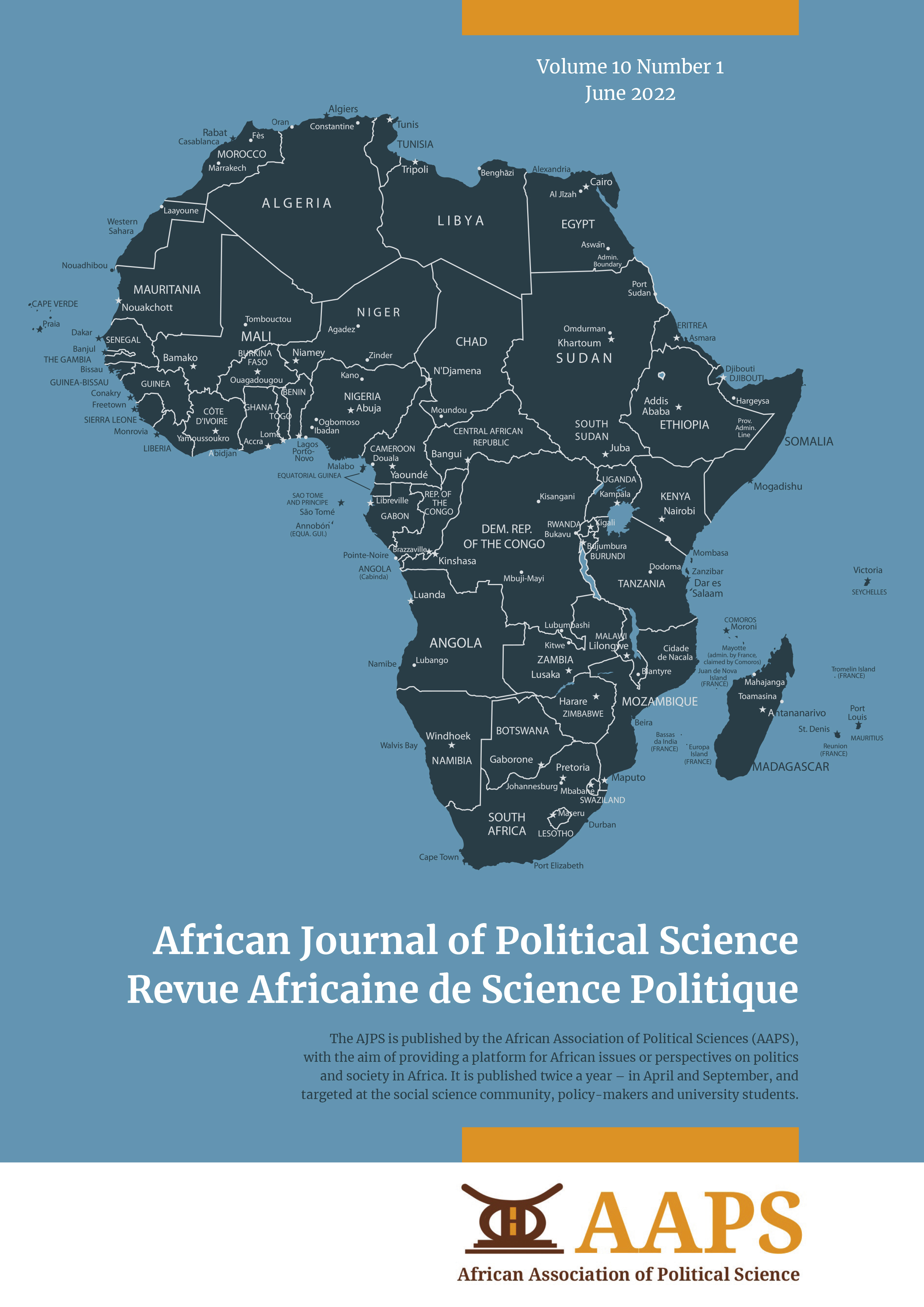Building an African Counter-Terrorism Architecture
Main Article Content
Keywords
Africa, Political Stability, Terrorism, Counter-Terrorism, Insurgency Groups
Abstract
Following September 11, 2001, terrorist attacks in the world trade centre in the United States of America, the phenomenon of terrorism has attracted increasing global attention. Coupled with this is the observable trend in the proliferation of terrorist groups in many parts of the world. To tackle these issues, nation-states, sub-regional, regional and continental bodies face the daunting task of evolving effective strategies for checkmating or containing the phenomenon. Indeed, many African countries have come to be faced with the problem of how to curtail the activities of terrorist groups, most of who operate on an established external link with notable and wealthy global insurgency groups. The overarching effects of these threats have become unprecedented and worrisome in sub-Saharan Africa. Thus, the search for practical solutions has been a challenge to scholars, state functionaries, and even attack victims. The paper provides an overview of the apparent vulnerability of the continent to increasing terrorist-related activities and the weak capacities of African countries’ leaders to respond to the unwholesome trend. Hence the call for developing a continental-counter terrorism strategy for the African continent.
Article Metrics Graph
References
Amistutz, R. (1982). An Introduction to Political Science: The Management of Conflict. USA: Pressman and Co. Glenview.
Baylis, J., Smith, S. & Owens, P. (2005). The Globalization of World Politics: An Introduction to International Relations, New York: Oxford University Press.
Boyle, M. J. (2008). The War on terror in America Grand Strategy. International Affairs, 84(2), 191-209. https://doi.org/10.1111/j.1468-2346.2008.00699.x
Commission on Global Governance, (1995). Our Global Neighborhood. Oxford: Oxford University Press.
Crensham, M. (2010). The Consequences of Counter-terrorism. New York: Russell Sage Foundation.
Dowd, C. & Raleigh, C. (2013). The Myth of Global Islamic Terrorism and Local Conflict in Mali and the Sahel. African Affairs, 112(448), 498-509. https://doi.org/10.1093/afraf/adt039
Ewi, M. & Plessia, A. (2014). Counter-Terrorism and Pan-Africanism. In Saul, B. (ed.), Research Handbook on International Law and Terrorism. Chelterham, UK: Edward Elgar.
Horgan, J. (2009). Walking Away from Terrorism. New York: Routledge. https://doi.org/10.4324/9780203874738
Horgan, J. (2005). The Psychology of Terrorism. New York: Routledge. https://doi.org/10.4324/9780203496961
Jackson, R. (2008). An Argument For Terrorism. Perspective on Terrorism, 2(2), 25-32.
Jervis, R. (2005). America Foreign Policy in a new Era. New York: Routledge.
Kafe, A. (2013) Preventing International Terrorism in Ghana: Realities and Challenges. This Dissertation is submitted to the University of Ghana, Legon in partial fulfillment of the Requirements of the Award of the Master Degree in International Affairs. July 2013.
Lalude, G. (2011). US reaction to Global Terrorism: The Oil Factor. Nigerian Journal of International Affairs, 37(3), 39-60.
Laqueur, W. (2000). The New Terrorism Fanaticism and the Arms of Mass Destruction. Oxford: Oxford University Press.
Makinda, S. (2007). Domestic Terrorism in Asia and Lessons for Africa 97- 101 in Domestic Terrorism in Africa: Defining, Addressing and Understanding its Impact on Human Security. Edited by Wafula Okumu and Anneli Botha. Institute For Security Studies. South Africa.
Nkrumah, K. (1961). Spread of Freedom: A Statement of African Ideology. New York: Praeger Publishers.
Norman, P. & Howard, P. (2007). International Relations. New Delhi: Vivendi Kumar Arya.
Norton, A. (2007). Hezbollah: A Short History. Princeton: Princeton University Press.
Pedahzur, A. & Ranstorp, M. (2001). A Territory Model for Counter-Terrorism in Liberal Democracies: The Case of Israel’. Terrorism and Political Violence, 13(2), 1-26. https://doi.org/10.1080/09546550109609678
Ramdeen, M. (2017). Countering Terrorism and Violent Extremism in Africa. Retrieved from https://www.accord.org.za/conflict-trends/countering-terrorism-violent-extremism-africa/.
Roggio, B. (2013). US adds Boko Haram, Ansaru to the list of foreign terrorist groups. Retrieved from https://www.longwarjournal.org/archives/2013/11/us_adds_boko_haram_t_1.php.
Rosenau, J. (1998). Governance and Democracy in a Globalizing World. In Archibug, D., Held, D. & Kohler, M. (eds.). Re-Imaging Political Community. Cambridge: Polity Press.
Sageman, M. (2004). Understanding Terror Networks. Pennsylvania: University of Pennsylvania. https://doi.org/10.9783/9780812206791
Schmid, A. (2009). Measuring Success and Failure in Terrorism and Counter-Terrorism: US Government Metrics of the Global War on Terror. In Schmid, A. & Hindle, G. (eds.). After the War on terror Regional and Multilateral Perspectives on Counter-Terrorism Strategy. London: RUSI Books.
Seteolu, D. (2004). The Challenge of Leadership and Governance in Nigeria. In Akhaine, O. (eds.). Governance: Nigeria and the World. Lagos: CENCOD.
Sharif, A. T. & Richards, J. (2016). ‘Towards a Continental Strategy for Countering Violent Extremism in Africa’, Retrieved from http://peaceoperationsreview.org/thematic-essays/towards-a-continental-strategy-for-countering-violent-extremism-in-africa/.
Stupart, J. (2013). The US Africa Command’s Continetal Shift: Five Years On. Africa Conflict Monthly Monitor, 2013(5), 39-42.
The Official Journal of the ECOWAS 1981.
United Nations Security Council. (2020). Security Council Issues Presidential Statement Calling for Greater Efforts to Help Africa Fight Terrorism, as Delegates Denounce ‘Insufficient’ Current Approaches. Retrieved from https://www.un.org/press/en/2020/sc14140.doc.htm
United States of America Army Manual No FM 3-0 Chapter 9, 37. 14 June 2001.
Vidino, L. (2009). Europe’s New Security Dilemma. The Washington Quarterly, 32(4), 61-75. https://doi.org/10.1080/01636600903224100
Wikinson, P. (2006). Frameworks for Conceptualizing Terrorism. Terrorism and Political Violence, 16(2), 197‑221. https://doi.org/10.1080/09546550490483134
www.uscode.house.gov/view.xhtml?path=/prelim@title18/part1/chapter113B&edition=prelim United States of America A Federal Criminal Code definition of terrorism
Zenn, J. (2014). Boko Haram: Recruitment, Financing, and Arms Trafficking in the Lake Chad Region. CTC Sentinel, 7(10), 5–9.





